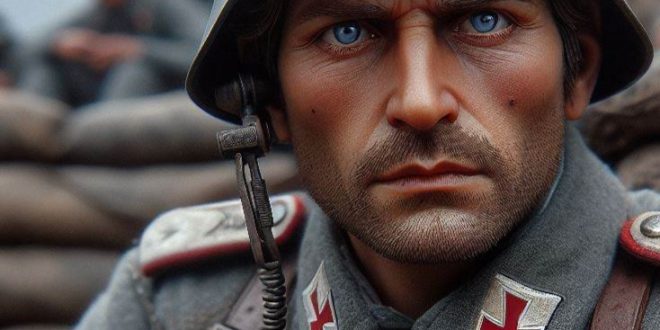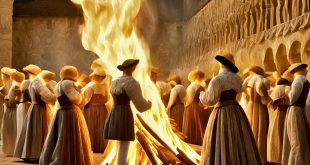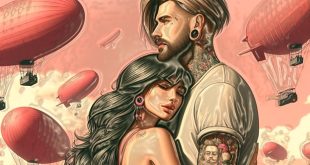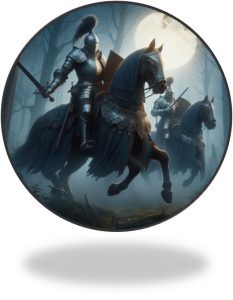 Set real and imaginary characters in a historical period
Set real and imaginary characters in a historical period
There are many novels in the history of literature https://www.goodreads.com/genres/historical-romance, but we have chosen only the five that have had great global resonance. The first, The Old Man and the Sea by Ernest Hemingway, tells the story of the fight between an old fisherman and a huge sailfish, symbol of the challenge between man and nature. Notre-Dame de Paris, a historical novel set in Victor Hugo‘s 15th century Paris, denounces social injustices, celebrates the value of art and tells the story of the bell ringer Quasimodo and his beloved Esmeralda, a gypsy accused of witchcraft. A detective novel set in a medieval abbey, The Name of the Rose by Umberto Eco, a work that mixes history, philosophy, literature and irony, tells the story of a Franciscan friar and his young pupil; you will discover that they must investigate a series of mysterious murders linked to a banned book. The Pillars of the Earth by Ken Follett, an epic novel that masterfully recreates the atmosphere and culture of the Middle Ages, follows the events of various characters involved in the construction of a Gothic cathedral in 12th century England, during a period of wars, intrigue and passions. Finally, Alexandre Dumas, with The Lady of the Camellias, a novel inspired by the real life of a famous courtesan, tells the tragic love story between her and a young bourgeois. Why not read it? It has moved generations of readers.
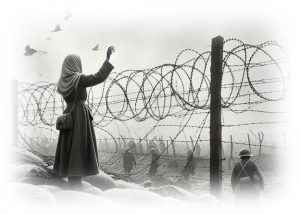 Writing a novel is a long and arduous process, rewarding and fun, but it is a creative and demanding activity that requires passion, discipline and dedication. Both to inspire you and to learn the techniques and styles they use; we recommend reading the works of other authors as well. There is no formula for writing a novel, and yet, you shouldn’t forget the existence of some tricks that can make your story effective and engaging. Before you start, you need to have a clear idea of what you want to tell, what the theme, genre, style and audience of your novel is. Then, you have to create the main characters, the ones who will bring your story to life; you will have to give them a psychological personality and physical appearance, desires, conflicts and motivations. To define the narrative structure of your novel, scenes and chapters, as well as times and places of the story, you can use maps to plan the plot and subplots. Finally, following your plan, but leaving room for your intuition, you need to write the first draft of your novel. These are just some tips for writing a novel https://blog.reedsy.com/guide/romance/how-to-write-a-romance-novel/, but there are also other methods you can find on the internet. By planning for the existence of two primary protagonists, one Italian and one Austrian, you could write a historical novel set in the First World War, on the Karst.
Writing a novel is a long and arduous process, rewarding and fun, but it is a creative and demanding activity that requires passion, discipline and dedication. Both to inspire you and to learn the techniques and styles they use; we recommend reading the works of other authors as well. There is no formula for writing a novel, and yet, you shouldn’t forget the existence of some tricks that can make your story effective and engaging. Before you start, you need to have a clear idea of what you want to tell, what the theme, genre, style and audience of your novel is. Then, you have to create the main characters, the ones who will bring your story to life; you will have to give them a psychological personality and physical appearance, desires, conflicts and motivations. To define the narrative structure of your novel, scenes and chapters, as well as times and places of the story, you can use maps to plan the plot and subplots. Finally, following your plan, but leaving room for your intuition, you need to write the first draft of your novel. These are just some tips for writing a novel https://blog.reedsy.com/guide/romance/how-to-write-a-romance-novel/, but there are also other methods you can find on the internet. By planning for the existence of two primary protagonists, one Italian and one Austrian, you could write a historical novel set in the First World War, on the Karst.
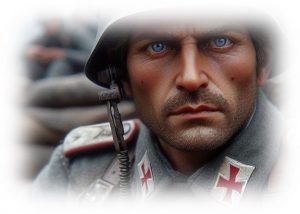 Franz, an Austrian officer of German origin, commands an infantry company on the Karst. He is a career soldier, loyal, disciplined and proud, but also cynical and disillusioned. He finds himself having to face the difficulties of war, the tensions between the different nationalities of the empire and doubts about his mission.
Franz, an Austrian officer of German origin, commands an infantry company on the Karst. He is a career soldier, loyal, disciplined and proud, but also cynical and disillusioned. He finds himself having to face the difficulties of war, the tensions between the different nationalities of the empire and doubts about his mission. 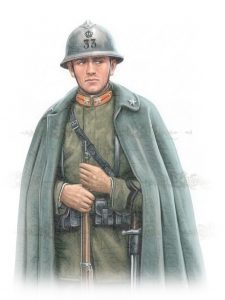 Marco, on the other hand, a young Italian soldier originally from Venice, had volunteered to free Trieste from Austrian oppression. He is idealistic, courageous and patriotic, but also naive and impulsive. He falls in love with a Slovenian girl who lives in a village near the front, but their love is hindered by war and prejudice. That Italian soldier was dressed in a grey-green cloth jacket and trousers, spring bands, a metal helmet and a rifle with bayonet. The grey-green uniform was introduced in 1909 to replace the previous light blue uniform, which was considered too visible on the battlefield. The helmet, however, was only adopted in 1915, following the French Adrian model. His rifle is a Carcano mod. 91 manual repeaters, has a six-round magazine. Marco attaches his bayonet to the muzzle of his rifle only for hand-to-hand combat.
Marco, on the other hand, a young Italian soldier originally from Venice, had volunteered to free Trieste from Austrian oppression. He is idealistic, courageous and patriotic, but also naive and impulsive. He falls in love with a Slovenian girl who lives in a village near the front, but their love is hindered by war and prejudice. That Italian soldier was dressed in a grey-green cloth jacket and trousers, spring bands, a metal helmet and a rifle with bayonet. The grey-green uniform was introduced in 1909 to replace the previous light blue uniform, which was considered too visible on the battlefield. The helmet, however, was only adopted in 1915, following the French Adrian model. His rifle is a Carcano mod. 91 manual repeaters, has a six-round magazine. Marco attaches his bayonet to the muzzle of his rifle only for hand-to-hand combat.
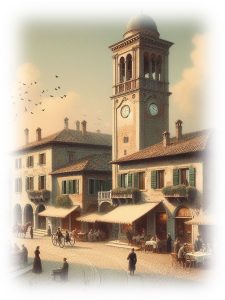 Marco approached the tavern with his heart in his mouth. It was the first time he had seen Magdalenka after two weeks in the trenches, where she had risked her life several times. He had obtained a two-hour break and wanted to take advantage of it to declare his love for her. He entered the tavern and looked around. The place was full of soldiers, farmers and workers, drinking, eating and chatting loudly. Marco looked around for Magdalenka, the beautiful Slovenian girl who worked as a waitress. He saw her in a corner, busy serving a table. She was dressed in a simple white apron, but to Marco she looked like an angel. Her blonde hair was tied in a braid, her blue eyes shone with sweetness, her smile was enchanting. Marco gathered courage and walked towards her. He came up behind her and whispered in her ear, “Hello, Magdalenka. I’ve been thinking about you a lot.” Magdalenka turned suddenly and saw Marco. Her face lit up with joy and surprise. She hugged him tightly and said: “Marco, you’re here! How nice to see you! How are you?”
Marco approached the tavern with his heart in his mouth. It was the first time he had seen Magdalenka after two weeks in the trenches, where she had risked her life several times. He had obtained a two-hour break and wanted to take advantage of it to declare his love for her. He entered the tavern and looked around. The place was full of soldiers, farmers and workers, drinking, eating and chatting loudly. Marco looked around for Magdalenka, the beautiful Slovenian girl who worked as a waitress. He saw her in a corner, busy serving a table. She was dressed in a simple white apron, but to Marco she looked like an angel. Her blonde hair was tied in a braid, her blue eyes shone with sweetness, her smile was enchanting. Marco gathered courage and walked towards her. He came up behind her and whispered in her ear, “Hello, Magdalenka. I’ve been thinking about you a lot.” Magdalenka turned suddenly and saw Marco. Her face lit up with joy and surprise. She hugged him tightly and said: “Marco, you’re here! How nice to see you! How are you?” 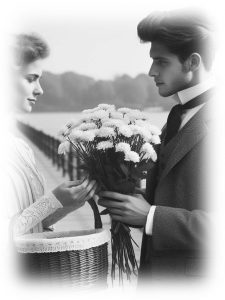 Marco handed her a bouquet of flowers that he had picked along the way, then, with her face red, he said to her: “I’m fine, thanks to you. I brought you a gift.” They were simple daisies, but to Magdalenka they seemed the most beautiful in the world. He took them gratefully and smelled them. She then kissed him tenderly on her lips. Marco felt a pang of happiness and emotion. He felt like the luckiest in the world. They joined hands and sat at an empty table. They looked into each other’s eyes and told each other their lives, their hopes, their dreams. They forgot about the war, about the danger, about the difference. They felt like just two lovers, who had found each other again after a long time. They looked out the window that overlooked the village square, and saw that the clock in the bell tower said noon.
Marco handed her a bouquet of flowers that he had picked along the way, then, with her face red, he said to her: “I’m fine, thanks to you. I brought you a gift.” They were simple daisies, but to Magdalenka they seemed the most beautiful in the world. He took them gratefully and smelled them. She then kissed him tenderly on her lips. Marco felt a pang of happiness and emotion. He felt like the luckiest in the world. They joined hands and sat at an empty table. They looked into each other’s eyes and told each other their lives, their hopes, their dreams. They forgot about the war, about the danger, about the difference. They felt like just two lovers, who had found each other again after a long time. They looked out the window that overlooked the village square, and saw that the clock in the bell tower said noon.
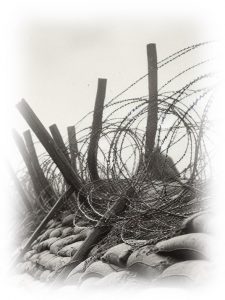 The Austrian uniform of the First World War consisted of a blue-grey jacket with collar and handguards of a different color depending on the department, trousers of the same color as the jacket or grey, black boots, leather belt and braces, cap or metal helmet. Franz also had a black saber with a silver hilt, and wore a blue-grey jacket with a cherry red collar and handguards and silver buttons. from the hill, he was observing with binoculars the same bell tower that Marco was looking at. The double-headed eagle on his brown belt with the silver buckle reminded him that there were enemies down there. Franz, the commander of an Austrian infantry company tasked with launching an attack against the Italian lines on the Carso, was sitting in his trench, anxiously awaiting the call from his superior. He knew it would be a difficult and dangerous mission, but he was ready to obey orders and do his duty. He held the field telephone in his hand, made of wood with a crank and a handset, connected to a cable that disappeared into the earth. The telephone was one of the most used means of communication during the First World War, especially to coordinate actions between artillery and infantry². Franz checked the time on his wristwatch. It was almost noon. The attack was scheduled for half past twelve. He had to receive final instructions from his colonel, who was in a rear command post. Suddenly, he felt a vibration in the receiver. Someone was turning the crank on the other end of the line, signaling the call. Franz raised the receiver to his ear and answered: “Hello, Captain Mayer here. Speak.”
The Austrian uniform of the First World War consisted of a blue-grey jacket with collar and handguards of a different color depending on the department, trousers of the same color as the jacket or grey, black boots, leather belt and braces, cap or metal helmet. Franz also had a black saber with a silver hilt, and wore a blue-grey jacket with a cherry red collar and handguards and silver buttons. from the hill, he was observing with binoculars the same bell tower that Marco was looking at. The double-headed eagle on his brown belt with the silver buckle reminded him that there were enemies down there. Franz, the commander of an Austrian infantry company tasked with launching an attack against the Italian lines on the Carso, was sitting in his trench, anxiously awaiting the call from his superior. He knew it would be a difficult and dangerous mission, but he was ready to obey orders and do his duty. He held the field telephone in his hand, made of wood with a crank and a handset, connected to a cable that disappeared into the earth. The telephone was one of the most used means of communication during the First World War, especially to coordinate actions between artillery and infantry². Franz checked the time on his wristwatch. It was almost noon. The attack was scheduled for half past twelve. He had to receive final instructions from his colonel, who was in a rear command post. Suddenly, he felt a vibration in the receiver. Someone was turning the crank on the other end of the line, signaling the call. Franz raised the receiver to his ear and answered: “Hello, Captain Mayer here. Speak.” 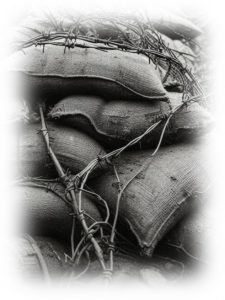 “Colonel Müller here. I am ready to give you instructions for the attack. Are you ready?” “Yes, sir. I’m listening.” “Good. The attack will begin at half past twelve sharp. You will have to get out of your trenches and advance towards the enemy positions, protected by the fire of our artillery. Your objective is Hill 142, where an Italian machine gun position is located, you will have to conquer it and hold the position until reinforcements arrive. Understood?” “Understood, sir. Hill 142. Conquer and hold.” “Very good. I wish you good luck, captain. Be brave and determined. For the emperor and for the country!” “Thank you, sir. For the emperor and for the country!” Franz hung up the receiver and put it back in the box. Then he stood up and turned to his men, who were looking at him expectantly. In a firm and confident voice, he repeated the instructions he had received. The soldiers nodded and prepared to carry out the order. Franz checked his rifle and pistol once again. Then he put on his helmet and adjusted his uniform. He looked at the sky, gray and cloudy. He sighed and thought about his family, his house, his life before the war. Then he pushed those thoughts away and focused on his mission. He was an officer, a soldier, a patriot. He had to do his duty, even at the cost of his life.
“Colonel Müller here. I am ready to give you instructions for the attack. Are you ready?” “Yes, sir. I’m listening.” “Good. The attack will begin at half past twelve sharp. You will have to get out of your trenches and advance towards the enemy positions, protected by the fire of our artillery. Your objective is Hill 142, where an Italian machine gun position is located, you will have to conquer it and hold the position until reinforcements arrive. Understood?” “Understood, sir. Hill 142. Conquer and hold.” “Very good. I wish you good luck, captain. Be brave and determined. For the emperor and for the country!” “Thank you, sir. For the emperor and for the country!” Franz hung up the receiver and put it back in the box. Then he stood up and turned to his men, who were looking at him expectantly. In a firm and confident voice, he repeated the instructions he had received. The soldiers nodded and prepared to carry out the order. Franz checked his rifle and pistol once again. Then he put on his helmet and adjusted his uniform. He looked at the sky, gray and cloudy. He sighed and thought about his family, his house, his life before the war. Then he pushed those thoughts away and focused on his mission. He was an officer, a soldier, a patriot. He had to do his duty, even at the cost of his life.
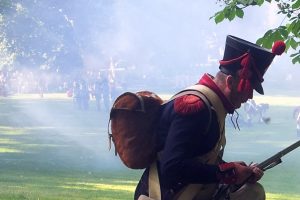 The historical novel blends narrative and history, but cannot be completely faithful to either. It aims to reconstruct a bygone era with the greatest possible fidelity, but without giving up creativity. It is based on careful research of sources, but interpreting them and transforming them into a compelling narrative. It tells the stories of those who have been forgotten by official history, allows you to travel through time and immerse yourself in worlds different from yours. I hope you enjoyed these considerations, and they encourage you to continue writing this historical novel. Now, continue on your own. I wish you happy writing! If you want to know other writers, you can type http://meetingbenches.com/category/library/, while for poets around the world http://meetingbenches.com/category/poetry/. The sole purpose of this site is to spread the knowledge of these artists and that other people enjoy their works. The property of the images that appear in this blog correspond to their authors.
The historical novel blends narrative and history, but cannot be completely faithful to either. It aims to reconstruct a bygone era with the greatest possible fidelity, but without giving up creativity. It is based on careful research of sources, but interpreting them and transforming them into a compelling narrative. It tells the stories of those who have been forgotten by official history, allows you to travel through time and immerse yourself in worlds different from yours. I hope you enjoyed these considerations, and they encourage you to continue writing this historical novel. Now, continue on your own. I wish you happy writing! If you want to know other writers, you can type http://meetingbenches.com/category/library/, while for poets around the world http://meetingbenches.com/category/poetry/. The sole purpose of this site is to spread the knowledge of these artists and that other people enjoy their works. The property of the images that appear in this blog correspond to their authors.
 Meeting Benches World art in all forms
Meeting Benches World art in all forms
